#PagePrinciples
Explore tagged Tumblr posts
Text
Wayfair Missteps in Employee Walkout
By Joshua Smyser-DeLeon
Summary of the Wayfair Walkout
Wayfair is a Boston-based e-commerce website that sells furniture and other home decor. They use a drop ship model to get their products into the hands of customers. A drop ship model is when a retailer buys a product, ordered by a customer, from its suppliers and has that product shipped to the customer that placed the order. For example, when you buy a lamp from Wayfair, Wayfair will buy that lamp from a supplier and have it shipped to you for the price you agreed to pay via their website. This means they never physically have the products they sell. With this model, Wayfair is able to sell over 14 million items. It has 11,000 suppliers as well as five additional websites Joss & Main, AllModern, Perigold, and Birch Lane. In 2018 alone, it made $1.5 billion in gross profit (Wischhover, 2019).
youtube
In mid-June 2019, Wayfair employees discovered that the Baptist Child and Family Services (BCFS), a detention center operator, placed a $200,000 bedroom furniture order. This bedroom furniture was for a migrant detention center housing children in Carrizo Springs, Texas (Bhattarai, 2019). In reaction, on June 21st around 540 Wayfair employees signed and sent a letter to executives challenging the ethics of the current and future B2B sales (Mabud, 2019). Executives responded with their own internal letter acknowledging the concerns of their employees, but that the order would still be fulfilled. In response, over 500 employees staged a “Wayfair Walkout” to protest the company’s business conduct on June 26th.

A Twitter account, @wayfairwalkout, was also created and the following demands were tweeted on the day of the walkout.
commitment to requests made in employee letter
donate profits of sales from BCFS and similar contractors to the Refugee and Immigrant Center for Education and Legal Services (RAICES)
stop doing business with BCFS and similar contractors
create a code of ethics for B2B sales
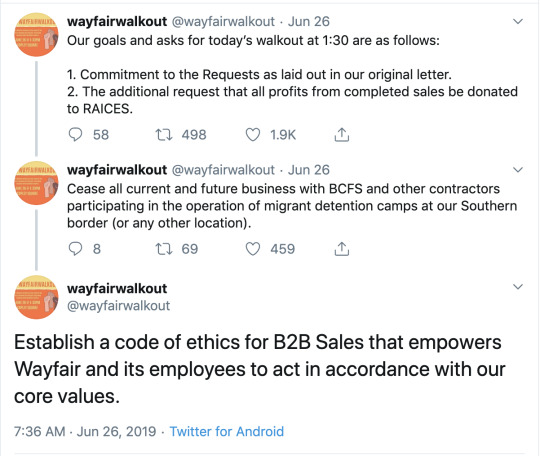
It is worth noting that these were not disgruntled employees. Organizers were quoted as saying, “We love Wayfair & working there. We don’t want to smear the CEOs. We just want to be able to feel proud of the work we do there.” (Matsakis, 2019). After the walkout, Wayfair still continued with the sale. Steve Conine and Niraj Shah, co-founders of Wayfair, announced a donation of $100,000 to the American Red Cross, not RAICES, in another letter to employees (Klar, 2019).
Reaction to the Wayfair Walkout
The “Page Principles” of telling the truth, proving it with action, and conducting public relations as if the whole enterprise depends on it could have all helped Wayfair navigate this situation (The Page Principles, n.d.). Let’s start with telling the truth.
youtube
Tell the Truth: On social media, the walkout gained attention. Unfortunately, Wayfair did not acknowledge the walkout or B2B sale on any of their social media channels. However, users expressed their displeasure with the sale in the comments section of the company’s Facebook, Instagram and Twitter pages. Protest organizers created a Twitter account the day before the walkout with the handle @wayfairwalkout. It had 22,000 followers by the day of the protest (Bhattarai, 2019). Elected officials, such as Rep. Alexandria Ocasio-Cortez (D-N.Y.) and Sen. Elizabeth Warren (D-Mass.), added their voices to the discussion as well.
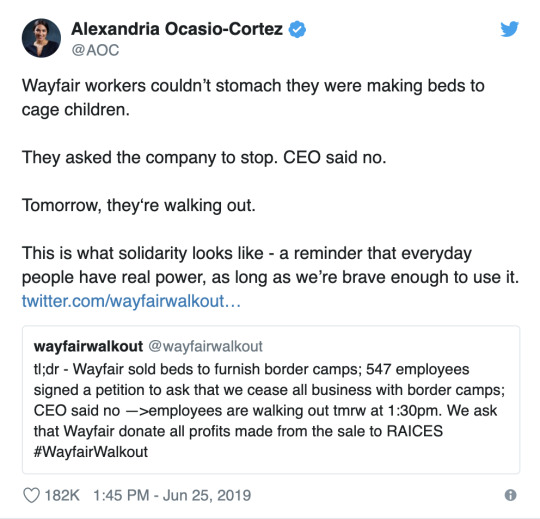
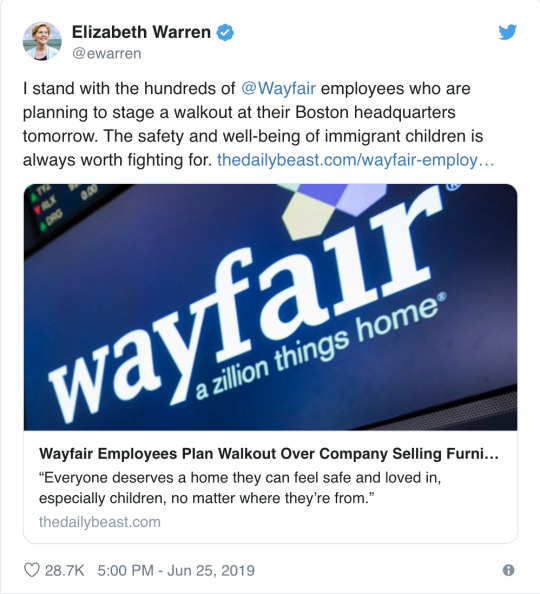
The employees that took part in this protest may have only represented 10 percent of the Wayfair workforce, but they were able to bring national attention to the ethical dilemma corporations may face when doing business with government contractors, especially as it relates to and reflects their stated company values.
youtube
In this case, Wayfair missed an opportunity to share why this sale reflected its values to its employees as well as to the public via their social media channels. In its mission statement, the company states that they “partner with organizations that play a meaningful role in creating safe and comfortable living spaces” and that they want to "make home a reality for more of the many people in need of safe shelter and basic household items that help make a home" (Social Responsibility, 2019). The connection could have been made that they are fulfilling this sale because they believe in creating as comfortable a living space as possible for detained migrants due to their belief in it being a basic human need and a foundation for a person’s well-being.
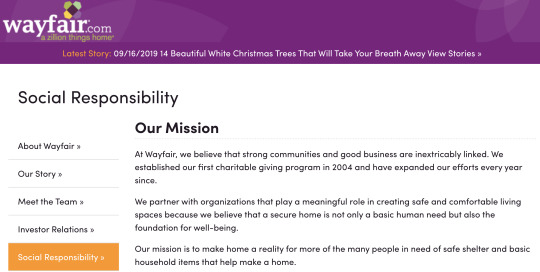
Prove It with Action: Words can only take a company so far. Instead of articulating the connection between the sale to BCFS with their values, Niraj Shah, Wayfair’s CEO, took a defensive stance and stated "it is standard practice to fulfill orders for all customers” and that they “sell to any customer who is acting within the laws of the countries within which we operate." They also intentionally ignored the request of their employees to donate to RAICES and instead donated to the Red Cross, which was half of what they earned from their BCFS sale. Both the words and actions of Wayfair showed a total disregard for their employees’ requests and desired outcomes.
Conduct Public Relations as if the Whole Enterprise Depends on It: They did not consider how the optics of their B2B sales with migrant detention center government contractors may seem to consumers and employees. Due to this, Wayfair opened itself up to criticism. Dedicating attention to consumer and societal trends could have helped avoid this situation to begin with. A 2018 Edelmen Earned Brand Study showed “that nearly two-thirds (64 percent) of consumers around the world now buy on belief” (Earned Brand 2018, 2019). This is up from 2017.
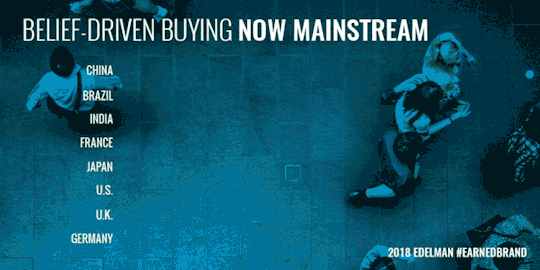
As a company based in the U.S., they would have benefited from educating themselves on the fact that a majority of Americans (62 percent) disapprove of the way migrants are treated at the border (Agiesta, 2019). This potentially translates into nearly 6 out of 10 people in their workforce having strong opinions on anything related to migrant treatment at the border. As of now, the financial effect this may have on Wayfair’s bottomline is yet to be determined. Brand loyalty may be a factor in the company's reported 40 percent more sales compared to last year. However, the company also reported a larger loss compared to last year. A year ago, they had a $100.7 million loss compared to $181.9 million this year (Thomas, 2019). With all the public attention on the company after the walkout, there may be a sense of urgency to invest more money into public-facing communications such as customer service and advertising. Time will tell if this strategy proves effective.
Sources
Agiesta, Jennifer. (2019, 2 July). CNN Poll: Three-quarters of Americans say there's a crisis at the border. CNN. Retrieved from https://www.cnn.com/2019/07/02/politics/cnn-poll-immigration-border-crisis/index.html
Bhattarai, Abha. (2019, 26 June). ‘A cage is not a home’: Hundreds of Wayfair employees walk out to protest sales to migrant detention center. The Washington Post. Retrieved from https://www.washingtonpost.com/business/2019/06/26/cage-is-not-home-hundreds-wayfair-employees-walk-out-protest-sales-migrant-detention-center
Earned Brand 2018. (2018, 2 October). Edelman. Retrieved from https://www.edelman.com/earned-brand
Klar, Rebecca. (2019, 26 June). Wayfair to donate $100,000 to Red Cross after employee protest over furnishing border facilities. The Hill. Retrieved from https://thehill.com/latino/450493-wayfair-to-donate-100000-to-red-cross-after-employee-protest-over-furnishing-border
Mabud, Rakeen. (2019, 12 July). Two Lessons From The Wayfair Walkout. Forbes. Retrieved from https://www.forbes.com/sites/rakeenmabud/2019/07/12/two-lessons-from-the-wayfair-walkout/#28c925cf3a88
Matsakis, Louise. (2019, 26 June). Wayfair Employees Are Walking Out. Here's Why. Wired. Retrieved from https://www.wired.com/story/wayfair-walking-out-border-detention
Social Responsibility. (n.d.). Wayfair. Retrieved from https://www.wayfair.com/v/about/social_responsibility
The Page Principles. (n.d.). Arthur W. Page Society. Retrieved from https://page.org/site/the-page-principles
Thomas, Lauren. (2019, 1 August). Wayfair shares whipsaw as costs build up and loss widens. CNBC. Retrieved from https://www.cnbc.com/2019/08/01/wayfair-reports-fiscal-q2-2019-earnings.html
Wischhover, Cheryl. (2019, 28 August). Wayfair, the internet’s massive online furniture store, explained. Vox. Retrieved from https://www.vox.com/2019/8/28/20833645/wayfair-many-brands-websites
#PRAD564#Wayfair#WayfairWalkout#WayfairMissteps#MigrantDetentionCenters#PublicRelations#ArthurPageSociety#PagePrinciples#Protest
0 notes
Photo

🌟 Arthur W. Page was a vice president and director of AT&T from 1927 to 1947. Known as “The Father of Corporate Public Relations,” Page revolutionized public relations practices and turned AT&T’s then-negative press around. The founders of the Arthur W. Page Society created these seven principles so the association's members -- and communicators in general -- could have tenets in which to practice public relations with honor and ethics. ➡️ Learn more in this week's blog post -- link in bio! #blog #blogpost #publicrelations #pageprinciples #hourglassprinciples #hourglassmedia #behindthehourglass #ethics #ethicsmonth https://ift.tt/2NN7EOS https://ift.tt/2UyqH0Q
0 notes
Text
Glossier: A Case Study in ‘Managing For Tomorrow’ & ‘Listening to Stakeholders’
Antoinette Iacullo

SUMMARY OF THE BRAND
New York-based ecommerce beauty startup, Glossier, launched online in 2014 with just four products. It has since expanded to a full line of skincare, makeup, body & fragrance products. It closed a Series C round of funding earlier this year, raising $52 million, bringing total funding to $86 million (Mandell, 2018). Rumors of an initial public offering began to simmer after the last funding round (Basin & Wolf, 2018).

Communication to Stakeholders (February 22, 2018)
Glossier’s valuation reached $390 Million this year (Olsen 2018).Traffic is heavy, both literally and digitally— Its flagship NYC store does more sales per square foot than the average Apple Store (Gingras 2018) and there are more than two million unique visitors a month to the brand’s beauty blog, Into the Gloss (Bhuiyan 2018).
Dear Tech People reports 79% of Glossier’s staff is female, including its CEO, Emily Weiss. Weiss, 33yrs old, went from Teen Vogue Intern to beauty blogger to the ‘Estee Lauder for millennials’ in roughly three years (Mandell 2018). You may remember Weiss from her cameo as Super Intern on the MTV series ‘The Hills.’

Above: Then, 2007.
Below: Now, 2018.

Photograph by Ben Hassett
youtube
Emily Weiss (Glossier) & Kirsten Green (Forerunner Ventures) | Disrupt SF
Another titan of retail, Katrina Lake, Founder and CEO of Stitch Fix, the youngest female founder to take a company public, joined Glossier’s board of directors in June. Lake is the first independent director to join the board, which includes Weiss, Glossier president Henry Davis and three venture capitalists (Del Rey, 2018).

Glossier is simultaneously innovating and disrupting ecommerce, with its tech-forward, direct-to-customer product and communication business model. It has a strong brand identity, synonymous with ‘Millennial pink’ and minimalist aesthetic, with a mission to serve as a conduit for connection. Glossier’s value is not in the sheer scale of its user base, rather, the social activity happening on its user network (Andjelic, 2018). And I would argue, much of Glossier’s value is its People Capital.
MY MUSINGS & REACTION
In a study of the 4-year old startup, via the lens of The Page Principles, ‘Manage For Tomorrow’ and ‘Listen to Stakeholders’ are seemingly embedded in Glossier’s core tenets. Meanwhile, ‘Conduct public relations as if the whole enterprise depends on it’ is a work in progress for this rapidly evolving Brand. And one I believe will only become more challenging, given Glossier does not appear to have a Chief Communications Officer; Instead, Weiss serves as the foremost voice and image of the Brand.
Manage For Tomorrow
Weiss believes “we’re really at the dawn of ecommerce,” which makes up just about 10% of global commerce (Olsen, 2018). “My job is to be thinking 12 months to two years ahead,” she writes in an ITG blog post (https://intothegloss.com/2016/01/meet-emily-weiss/).
Glossier quietly acquired Montreal Digital agency, Dynamo, at the close of 2017. Dynamo helped Glossier with its U.S. launch, developing its website and ecommerce platform. Following the acquisition, Dynamo Co-Founder Bryan Mahoney was named CTO at Glossier (Kolm, 2018).
With the additional venture capital funding injected in February, Glossier is preparing to enter “Phase Two,” creating a social-commerce site. Though Glossier’s Instagram account has roughly 1.5 million followers, Weiss wants to build her own version of a social media and shopping mashup and she hired Keith Peiris, a developer who led teams at Instagram, Facebook Inc., and Oculus, as Glossier’s product chief to spearhead the new site (Perez, 2018).
Listen to Stakeholders
Glossier launches a new product every six weeks, on average, and spends a lot of time working on its formulas and engaging in two-way conversation between product teams and its user community. For example, crowd-sourcing input to co-create its cornerstone product, Milky Jelly Cleanser and inviting 100 of Glossier’s top customers to participate in a Slack channel, exchanging thousands of messages weekly. “That’s the difference between a marketing tactic and actually having your customer engaged in your process and your brand,” says Weiss (Chapin, 2016).


How to not conduct PR as if the whole enterprise depends on it
Glossier has been criticized for not being particularly concerned with explaining the science behind its products, “Weiss just doesn’t think her customers care about ingredients if they’re happy with the results,” according to a spokesperson for Glossier (Larocca, 2018). But Glossier claims that its lack of transparency is a matter of safeguarding business assets.

Glossier received backlash in response to its Instastory thread, which promoted the benefits of Glossier’s Solution, a chemical exfoliating toner, while slamming competing products from industry-revered brands, like Biologique. Many felt Glossier was ill-positioned to opine on other acid formulas when the percentages of its proprietary acid blend are not disclosed. Further, Glossier’s authoritative voice on chemical products felt ingenuine, when fragrance, a known skin irritant, is a listed ingredient in Glossier’s Solution. Further hypocritical, Glossier threw shade at the same competitors that it previously lauded on Into the Gloss.
Luckily, Glossier’s brand image of inclusivity and transparency seems largely intact since its very off-brand misstep, but as Warren Buffet has cautioned, it takes significantly less time to ruin your reputation than it takes to build it.
SOURCES
Andjelic, A. (2018, October 19). Opinion: The ‘4 Cs’ of the modern beauty brand. Glossy. Retrieved from http://db.glossy.co/platform-effect/opinion-the-4-cs-of-the-modern-beauty-brand
Bhasin, K. & Wolf J. (2018, August 30). Inside Glossier’s plans to shake up your makeup routine. Bloomberg. Retrieved from https://www.bloomberg.com/news/features/2018-08-30/millennial-makeup-brand-glossier-shakeup-makeup-routine
Bhuiyan, J. (2018, September 18). Emily Weiss wants Glossier to own the online beauty conversation. Recode. Retrieved from https://www.recode.net/2018/9/18/17869814/glossier-emily-weiss-makeup-beauty-engagement
Chapin, A. (2016, January 11). Emily Weiss explains why people are freaking out about Glossier. Racked. Retrieved from https://www.racked.com/2016/1/11/10749536/glossier-emily-weiss-into-the-gloss-new-cleanser
Del Rey, J. (2018, June 26). Stitch Fix CEO Katrina Lake has joined the board of Glossier. Recode. Retrieved from https://www.recode.net/2018/6/26/17501370/katrina-lake-glossier-board-director-stitch-fix
Gingras, M. (2018, April 18). While retail’s behemoths die, these 4 retailers are rising from their ashes. Entrepreneur. Retrieved from https://www.entrepreneur.com/article/312112
Kolm, J. (2018, March 2). Glossier acquired Dynamo. Strategy. Retrieved from http://strategyonline.ca/2018/03/02/glossier-acquires-dynamo/
Larocca, A. (2018, January 8). The magic skin of Glossier’s Emily Weiss. New York Magazine. Retrieved from https://www.thecut.com/2018/01/glossier-emily-weiss.html
Mandell, J. (2018, February 22). Glossier just got $52 million in fresh capital, bringing total funding to $86 million. Forbes. Retrieved from https://www.forbes.com/sites/jannamandell/2018/02/22/glossier-just-got-52-million-in-fresh-capital-bringing-total-funding-to-86-million/#1a1dd56412b6
Olsen, D. (2018, September 2018). The changing face of beauty brands in an Instagram-obsessed world. PitchBook. Retrieved from https://pitchbook.com/news/articles/the-changing-face-of-beauty-brands-in-an-instagram-obsessed-world
Perez, S. (2018). Glossier CEO Emily Weiss on why the company won’t sell to Amazon. Tech Crunch. Retrieved from https://techcrunch.com/2018/09/07/glossier-ceo-emily-weiss-on-why-the-company-wont-sell-on-amazon/
0 notes
Text
Tesla’s self-driving car involved in fatal car crash

SUMMARY
On May 7, 2016 the first fatal car crash involving a self-driving car occurred in Williston, Florida when the driver of Tesla’s Model S, Joshua Brown, crashed into the side of an 18-wheeler while in autopilot mode (Vlasic, 2016). In reaction to the crash, Tesla wrote:
Neither Autopilot nor the driver noticed the white side of the tractor trailer against a brightly lit sky, so the brake was not applied. The high ride height of the trailer combined with its positioning across the road and the extremely rare circumstances of the impact caused the Model S to pass under the trailer, with the bottom of the trailer impacting the windshield of the Model S. Had the Model S impacted the front or rear of the trailer, even at high speed, its advanced crash safety system would likely have prevented serious injury as it has in numerous other similar incidents. (2016)
In the release, Tesla also stated that its self-driving cars are statistically safer than traditional vehicles, specifying that, in the U.S., fatal accidents occur every 94 million miles in traditional vehicles while cars in Autopilot mode now have a fatal accident occurring every 130 million miles (2016). Furthermore, Tesla reminded the public that the autopilot mode is still in beta stage and is still being improved. Although the car can proceed without a driver’s hands on the steering wheel, the car constantly reminds drivers of their responsibility to maintain control of the car at all times with their hands placed on the steering wheel (2016).
Although the crash occurred on May 7, Tesla did not publish the above information until June 30, nearly two months after the crash occurred, after the National Highway Traffic Safety Administration (NHTSA) announced a further investigation of the crash and Tesla’s autopilot mode.
Furthermore, on May 18, Tesla and Elon Musk, the CEO of Tesla, sold more than $2 billion of Tesla stock in a public offering at $215 per share, without disclosing any information about the crash to its stakeholders. Musk has claimed that the crash was not material information saying, “Indeed, if anyone bothered to do the math (obviously, you did not) they would realize that of the over 1M auto deaths per year worldwide, approximately half a million people would have been saved if the Tesla autopilot was universally available. Please, take 5 mins and do the bloody math before you write an article that misleads the public,” (Loomis, 2016). It is also important to note, that when the information on the crash was released, the stock dropped from $212 to $206 but then reversed and closed the day at $216 (Loomis, 2016).

REACTION
Upon hearing the news of the crash, I was not surprised or upset by the fact that a self-driving car was involved in a fatal car accident. As Tesla stated in its release, self-driving cars are statistically safer than traditionally driven cars, and I do not believe that we can expect them to prevent 100 percent of crashes. However, Tesla’s communication of the accident could be greatly improved. The company did immediately notify the NHTSA of the crash after it occurred, but knowing the novelty of the technology, the public, or at least the company’s stakeholders, should have been informed of the crash as well. According to the New York Times, an analyst at Kelley Blue Book claimed that the accident could be a sign that self-driving technology was not yet ready to share with the market (Vlasic, 2016). Although this is debatable, Tesla should have abided by the fifth Page Principle which states, “No strategy should be implemented without considering its impact on stakeholders.” By doing so, Tesla would have allowed its stakeholders to react according to their diverse range of views and values.
The Page Principles also state that a company should, “Tell the truth;” “Prove it with action;” and “Listen to stakeholders.” By withholding the information about the crash for nearly eight weeks, Tesla was not transparent with its stakeholders and did not allow them the opportunity to choose how to handle their share of the company. Tesla further betrayed the public by selling a large portion of its stock before releasing the news of the crash. Whether it was deemed material information or not, Tesla should have been totally transparent throughout the entire ordeal. In choosing to act without full-disclosure, Tesla did not properly maintain its reputation or prove its loyalty to its stakeholders.
References
Loomis, C. (2016, July 5). Fortune. Retrieved from http://fortune.com/2016/07/05/elon-musk-tesla-autopilot-stock-sale/
Tesla. (2016, June 30). Tesla.com. Retrieved from https://www.tesla.com/blog/tragic-loss
Vlasic, B. (2016, June 30). The New York Times. Retrieved from http://www.nytimes.com/2016/07/01/business/self-driving-tesla-fatal-crash-investigation.html?_r=2
0 notes